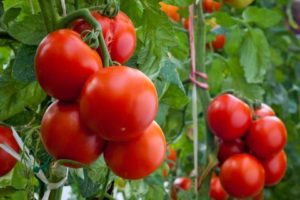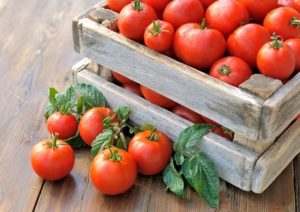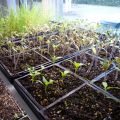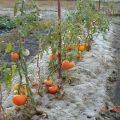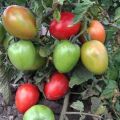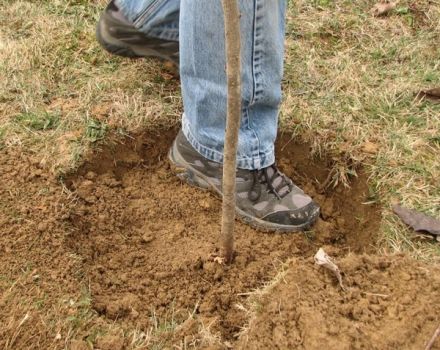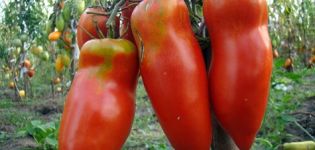Characteristics and description of the tomato variety Yellow giant
Choosing tomatoes for planting on your personal plot, you can look at plants with fruits of unusual colors. For example, the Yellow Giant tomato has a good yield, the fruits are quite sweet and are suitable for consumption, as a rule, fresh.
Content
This tomato is not suitable for long-term storage, but this is offset by a long fruiting period. You can have fresh tomatoes on your table almost all season.
Varietal characteristics
This tomato is an indeterminate plant with mid-season fruits, the height of adult bushes is 1.2 - 1.7 meters. Tomatoes are large, yellow in color when ripe. Tomatoes are classified as a salad variety, but can be used for canning by cutting them into slices.
From the moment of germination to the first harvest of tomatoes, 110 - 122 days should pass. The yield is up to 5.5 kg from 1 one bush.
A positive characteristic of the variety is that fruiting lasts 1.5 months. Fruits can weigh up to 400 g with proper care. The shape of the Yellow Giant Tomato is round, slightly flattened, sweetish, honey taste.
The description of the variety shows that such a giant tomato is not contraindicated for allergy sufferers, it is recommended for baby food, weakened and elderly people. The presence of a large amount of niacin in tomatoes helps to strengthen blood vessels and normalizes the heart. Tomato yellow has a positive effect on the liver, kidneys and gastrointestinal tract.
Tomato growing rules Yellow giant
This tomato variety can be grown both in the greenhouse and outdoors. The height of the bushes in greenhouse plants will be slightly higher than that of tomatoes planted outside of it. Greenhouse fruits may ripen earlier. Growing seedlings in pots begins 2 months before planting them in the soil.
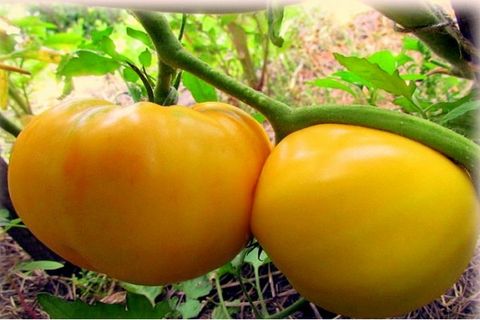
Since the bushes have high stems, you need to build a trellis. When planting seedlings, their further growth should be foreseen and more space should be left than for low-growing varieties. When growing a yellow giant tomato, stalking is required. Bushes bear fruit most productively if two large stems are left on them.
Tomato pests and diseases
Although the bushes look very strong, they are not resistant to diseases. Tomatoes of this variety are most susceptible to such diseases: late blight, alternaria, tobacco mosaic and other diseases affecting nightshade crops.Reviews of gardeners indicate the need for preventive treatment with fungicides.
Among the pests for tomatoes, the Colorado potato beetle is considered the most dangerous, which can completely destroy tomato seedlings or small bushes.
Soil pretreatment for tomato
The land for the future planting of a tall tomato bush begins to be prepared in the fall. The soil is plowed and fertilized. It is considered optimal to apply rotted manure at this time in the amount of 4 kg per 1 sq. m. The same amount of organic matter is reintroduced in the spring, adding 1 tbsp. l. potassium chloride and 1 tbsp. l. superphosphate.
Planting tomato seedlings
Sowing seeds for seedlings is done in the last week of February. At least 2 months should pass before planting in the soil or greenhouse.
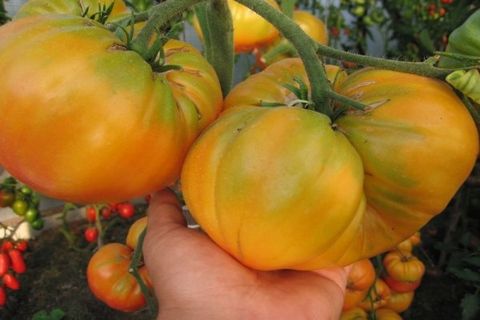
The best indicators of germination, cultivation and yield in tomatoes from seeds purchased in specialized stores. If you plan to harvest seeds from your harvest, you should leave them on the bushes until fully ripe, choosing the fruits of the most correct shape. After cutting, the tomatoes are placed on the windowsill of the sunny side of the house. After the fruits become soft, their middle is taken into a container with water and kept in it for 2 - 3 days. Then the seeds are washed and laid out on a flat surface, for example, on a paper sheet to dry.
Before sowing, it is advisable to treat tomato seeds with a special solution. It can be prepared by diluting one of the following agents in 1 liter of water: liquid fertilizers (Agricola-Vegeta and Effekton), nitrophoska or wood ash. The seeds are soaked for 1 day, and then they are taken out, slightly dried, placed in an airtight bag and put in a refrigerator. This procedure helps to harden the seeds. After two days in the refrigerator, the seeds can be planted in the soil.
Preparing soil for tomato yellow giant
For planting seeds for tomato seedlings, soil is used, consisting of peat soil, rotted humus and turf. It is advisable to bake it in a heated oven for 20 minutes.
The temperature should be set at 100 - 115 degrees. The soil is poured into a baking sheet in a layer of no more than 4 cm. To 10 kg of such a substance, 1 tsp is added. granular superphosphate, potassium sulfate and urea.
Sowing tomato seeds
On the day of sowing, the soil in the containers is moistened and leveled. Then grooves are made 1 cm deep with a distance between similar depressions of 5 - 6 cm. Each seed is placed at a distance of two centimeters from the next. The furrow is sprinkled on top with a layer of soil mixture. Additional watering of the planted seeds is not required.
Boxes with containers are placed on the south side of the house so that sunlight can enter the room. The room temperature should be about +22 - 25 degrees on average.
A week after germination, a pick is carried out with transplanting the tomatoes into another container.
Planting seedlings of the Yellow Giant in the ground
Somewhere in the middle of May is the ideal time for transplanting tomato seedlings into open ground. To protect the seedlings of tall seedlings, the plants are sprayed with copper oxychloride. It is enough to dilute 1 tbsp in 1 liter of water. l. the drug is 90% concentration.
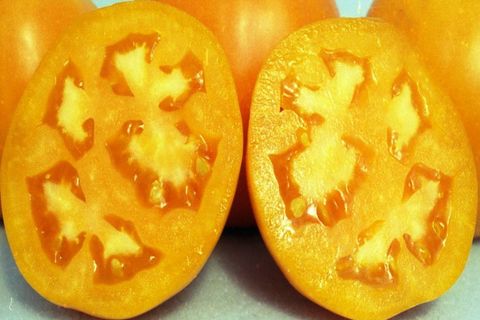
In the ground, holes are made in the size of 15x15 cm. They can be placed both in the same row and in a checkerboard pattern. Place 1 tomato bush in each hole. There must be a distance of at least 60 cm between the holes.
Top dressing when growing tomato
Gardeners with experience are advised to carry out a three-time feeding tomatoes over the summer period. The first is done 10 days after planting the seedlings in the soil.For this purpose, a talker is prepared from poultry manure or cow dung by diluting 1 kg per 10 liters of water.
You can use ready-made fertilizers such as "Gumisol", "Vermistim", "Rost-concentrate". The description for these preparations gives recommendations for their introduction into the soil.
After each feeding, it is advisable to mulch the soil. Organic matter is scattered in a layer of up to 5 cm over the garden, using sawdust, straw or pine needles as mulch. This prevents the rapid evaporation of moisture from the soil and interferes with the germination of weeds.
The next feeding of tomatoes is performed 7 days after the tomato ovary on the second brush. At this stage of tomato growth, fertilizer is applied to the soil from a solution of poultry manure or manure, as in the first feeding. A mixture for feeding is prepared from "Solution", This time the additive consists of fertilizer "Solution", copper sulfate and potassium permanganate (3 g per 1 bucket of water). 2 liters of fertilizer are poured under each tomato bush.
The last feeding of the tomato is carried out during the beginning of ripening of the first crop of tomatoes. The composition of the talker is similar to the second feeding, but 2.5 liters of such a mixture is poured under each bush.
If, after feeding, the tomatoes cease to form new fruits and the stems begin to grow actively, this indicates an excess of nitrogen fertilizers in the soil. In this case, the tomatoes are watered superphosphate extract.
